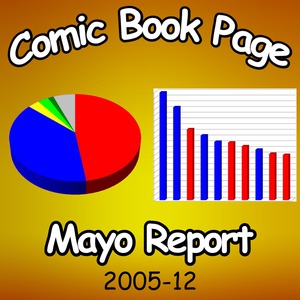Mayo Report for 2005-12

|
At the time this episode was recorded, the ICv2 numbers weren't out yet for 2005-12 so I used a Diamond Order Index number of 675 as a ballpark. I was also going off the ICv2 list while the other people in the discussion were looking at the CBG list.
Below are the notes I tossed together over the course of that afternoon in the few hours notice I was given before the podcast was recorded. I hadn't had time to load the data into my computer much less crunch the numbers prior to this and had to all of that in the span of a few hours.
A lot of ground was covered in this initial discussions. Much of the discussion centered around what the Diamond data is and isn't. I explained the nature of the relative percentages listed for each item as compared to a baseline item which is usually Batman. We discussed the way that the Diamond data gets covered into estimated number of units by taking information from various publishers and doing the math. Once you have the data it isn't hard to do this math but you need to understand how the data is structured and what it is.
In the discussion, I stressed that these numbers were estimates of the number of units bought by retailers within the direct market served by Diamond USA for the month. This information isn't net sales to readers or sell through information and that not all of the comis actual sell to readers. The concept of having a BookScan sort of system for comic books and how the direct market isn't the entire market was also discussed. I gave examples of point-of-sales systems that we had seen at local stores. Some of the various reasons why some comic book stores may not have or use those a point of sales system.
The conversation shifted from the itemized receipts I got from the local store into questions about my spending and my collection. The digression into the size my comic book collection was (33,355 or so) and aspects of how I organize lasted for probably longer than it should have.
Before going over any of the numbers we made sure to give a "take these estimates for what they are" disclaimer. We also reminded listeners that we are not making any value judgements on content but were strickly discussing how things sold to retailers.
Some of the things that came up while going over the numbers was the trend for ongoing titles to routinely drop in sales from issue to issue. The concept of there possibly be a "glass floor" for comic book periodical sales and how that might cause a flip towards a trade paperback based industry was mentioned.
A few of the sales gimmicks that we discussed were new #1s, crossovers, big name creators, variant covers, "magic numbers" (like Catwoman #50) and how these gimmicks rarely have any sort of long term impact on sales. The irony of people vocally complaining about a comic yet still buying it was discussed in terms of All Star Batman and Robin the Boy Wonder.
A lot of time in this discussion was spent on "big picture" aspects of the general subject of comic book sales estimates and sales trends.
Top Comics List Top Comics Breakdown Top Trades List Top Trades Breakdown
OVERVIEW
- Pre-Order Charts: 2002-02 to 2003-03
- Final Order Charts: 2003-03 to 2005-12
- Numbers from Diamond and ICv2.com (thanks, Milton Griepp)
- these numbers are the final order from RETAILERS for the month
- No Sell-Through:
- no information about sales to readers exist
- sales to retailers are non-returnable
- comics might sit on store shelves forever
- only included direct market
- does not include:
- Diamond UK
- orders placed after the end of the month
- copies purchsed by Diamond and kept in inventory
- does not include bookstores, newstand, etc
- Batman is the benchmark title
- always = 100.00
- X-Men used to be the benchmark title until Marvel attempted self-distribution
- Reorder activity can be huge sometimes:
- Villians United #1:
- 96,750 in the first month
- 19,500+ after the first month
COMICS
- Marvel: 90 -2x of X-Men, Spider-Man/Black Cat, Ultimate Spider-Man
- DC: 75
- Dark Horse: 16
- Image: 32
- Rank #1: Infinite Crisis #3: ~202,000-ish
- Rank #7: Ultimates 2 #9: ~101,000-ish
- Rank #37: Wonder Woman #224: ~50,500-ish
- Rank #99: Firestorm #20: ~25,000-ish
- Rank #29: Son of M #1: ~66,500-ish -- Low start, will probably only go down from here
- Rank #30: Ghost Rider #4: ~63,750-ish -- first item on the list that I didn't get
- Rank #31: Spider-Man/Black Cat: Evil That Men Do #4: ~61,000-ish
- Rank #33: Spider-Man/Black Cat: Evil That Men Do #5: ~57,500-ish
- (2002-06) Rank #2: Spider-Man/Black Cat: Evil That Men Do #1: 126,808 (Pre-order)
- (2002-07) Rank #5: Spider-Man/Black Cat: Evil That Men Do #2: 108,778 (Pre-order)
- (2002-08) Rank #7: Spider-Man/Black Cat: Evil That Men Do #3: 105,887 (Pre-order)
- (2002-09) Rank #5: Spider-Man/Black Cat: Evil That Men Do #4: 101,153 (Pre-order)
- (2002-10) Rank #9: Spider-Man/Black Cat: Evil That Men Do #5: 98,163 (Pre-order)
- Rank #60: Conan #23: ~35,00-ish --Dark Horse, first non Marvel/DC in top 300
- Rank #125: Spider-Girl #93 ~18,250-ish, up from #92?
- 18,500 = "Line of Death" at Marvel?
- Rank 150: X-Men Deadly Genesis #1 ~13,000-ish REORDER
- Rank #207: PvP #21 ~6,250-ish -- funny
- Rank #219: Atomika #5 ~5,000-ish -- mentioned before on the podcast
- Rank #223: Maze Agency #1 ~4,600-ish -- Good fair play detective stories
- Rank #227: Noble Causes #15 ~4,500-ish -- celebrity super-hero family
- Rank #234: Infinite Crisis #2 ~4,100-ish REORDER
- Rank #261: XII #4 ~2,750-ish -- along the lines of Bourne Identity
- Rank #277: XII #5 ~2,500-ish
- Rank #273: Grimiore #7 ~2,600-ish -- Good book from Speakeasy (hard to describe)
- Rank #282: Infinite Crisis #1 ~2,250-ish REORDER
- Rank #294: Free Fall #1 ~2,000-ish -hiest film premise, good art, recommended (5 issue limited series)
- Rank #300: Amazing Spider-Man #526 1,750-ish -- REORDER
